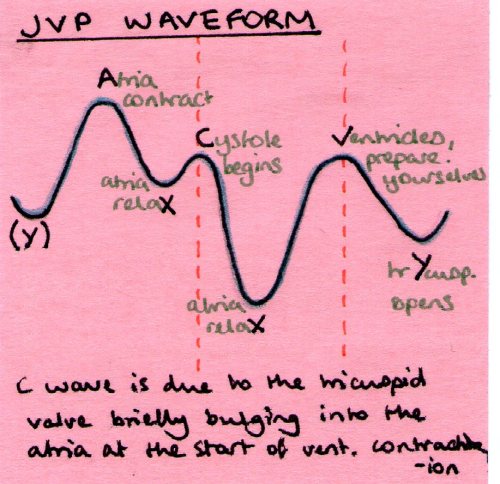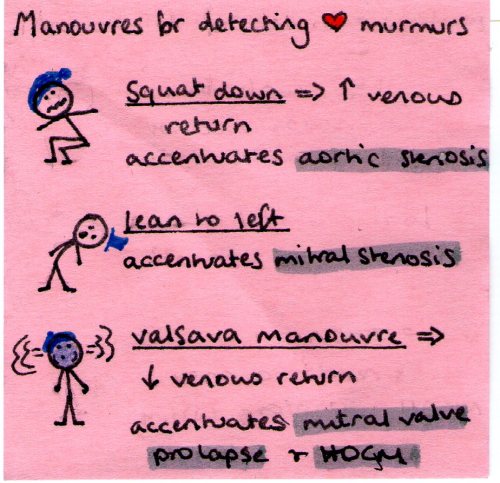#medicine by post it note
Descending tracts in the spinal cord. Descending tracts are generally motor, and are divided into pyramidal tracts (cotricospinal and corticobulbar - i.e. the voluntary ones) and extra-pyramidal (all the others).
Corticospinal tract: carries motor fibres. Has an anterior (15%) and a lateral (85%) branch. Anterior controls the axial muscles while the lateral controlslimbs and skilled movements. They decussate in slightly different places, with the LCS crossing in the lower medullary pyramids, and the ACS at the spinal level they exit through.
Corticobulbar: not seen on this diagram because it doesn’t actually make it into the spinal cord. It terminates on cranial nerve motor nuclei to deal with motor functions of cranial nerves: facial expression, extra-ocular, etc.
Vestibulospinal: controls balance. It is special because it remains ipsilateral. Someone with a lesion of the vestibulospinal tract will fall (due to loss of balance control) towards the side of the lesion.
Reticulospinal: deals with reflexes. Has two branches, the pontine branch does extensor reflexes exclusively, while the medullary does both extensor and flexor. It also stays ipsilateral.
Tectospinal: another reflex type tract, that responds to visual and auditory stimuli. It is the reason that blind people can sometimes turn their head towards a flashing light without seeing it, but sensing it. Spooky.
Rubrospinal: bit vestigial in humans to be honest, most of its functions have been superseded by the corticospinal tract with which it joins in the lateral column of the spinal cord.
Post link
I can never remember what the different bits are on a JVP wave so here is a way to try and remember it. It’s a bit contrived, what with Cystole and trYcuspid but silly things are easier to remember.
C is the tricuspid valve closing and kind of bulging as it does. Imagine it over shooting ever so slightly then recoiling back into place.
V is the atria refilling, hence why the ventricles need to prepare for the next onslaught.
The letter refers to the bit of waveform that happened just before it. So when the atria contract they cause a bit of backflow, so the pressure in the jugular vein increases (there’s no valve into the atria, only out) causing the upswing. Then the atria relax so blood can flow into said atria, so the jugular vein empties and the pressure goes down.
Just remember that it’s the JUGULAR VENOUS pressure. Not the right atrial pressure. They’re similar, but not the same.
Post link
Amsel criteria for diagnosis of bacterial vaginosis. It occurs when the balance of bacteria that naturally occur in the vagina becomes disrupted (usually the lactobacilli number goes down), so some get to predominate leading to symptoms of an infection. IT IS NOT AN STI. One of the common causes is excessively cleaning the vagina. Patients like it when you emphasise this.
Usually they’re anaeroboes so treat them with metronizadole. No need to treat the partner. Tah dah.
Post link
For looking swish in an OSCE.
Also an SBA question setter’s dream.
Though the types of patients who get aortic stenosis are generally not the type that are even able to squat so it’s a bit academic.
Post link
A brief overview of the features of HHT.
Treatment is symptomatic - deal with problems as they arise. Cautery, embolisation, iron supplements, etc. Generally patients have a normal lifespan, with nosebleeds being the most problematic feature.
Post link
Believe it or not, if you google “pandas” this disease does in fact make an appearance on the first page. Didn’t the consultant feel silly though when he typed it in and the first thing that appears is all these pictures of pandas.
It’s a bit obscure, but it is the abrupt onset (or sudden dramatic worsening) of OCD and/or Tourette like syndromes following infection with group A beta haemolytic strep - such as with strep throat and scarlet fever. It is thought it might be an autoimmune response (“molecular mimicry” which is a term I have fondness for), similar to sequale of rheumatic fever (valve disease, chorea).
Mostly I felt like drawing a panda. I copied it from this guy.
Post link
ATOMIC - an acronym for remembering the six causes of breathing problems that should be noted on the primary survey in a trauma patient.
A. airway obstruction
T. tension pneumothorax
O. open pneumothorax
M. massive haemothorax
I. intercostal disruption - i.e. flail chest where a set of ribs have detached and are floating free in the chest. An indicator of severe chest trauma.
C. cardiac tamponade
The fluffy things in the collapsed lung are clouds. It’s meant to signify that there’s air in there. I’m not sure how successful that was…
Post link
Some associations of Dupuytrens contracture that are useful to be aware of. Some are well established (family history) and some are quite tenuous (manual labour) but are still worth asking about in a history.
Post link









